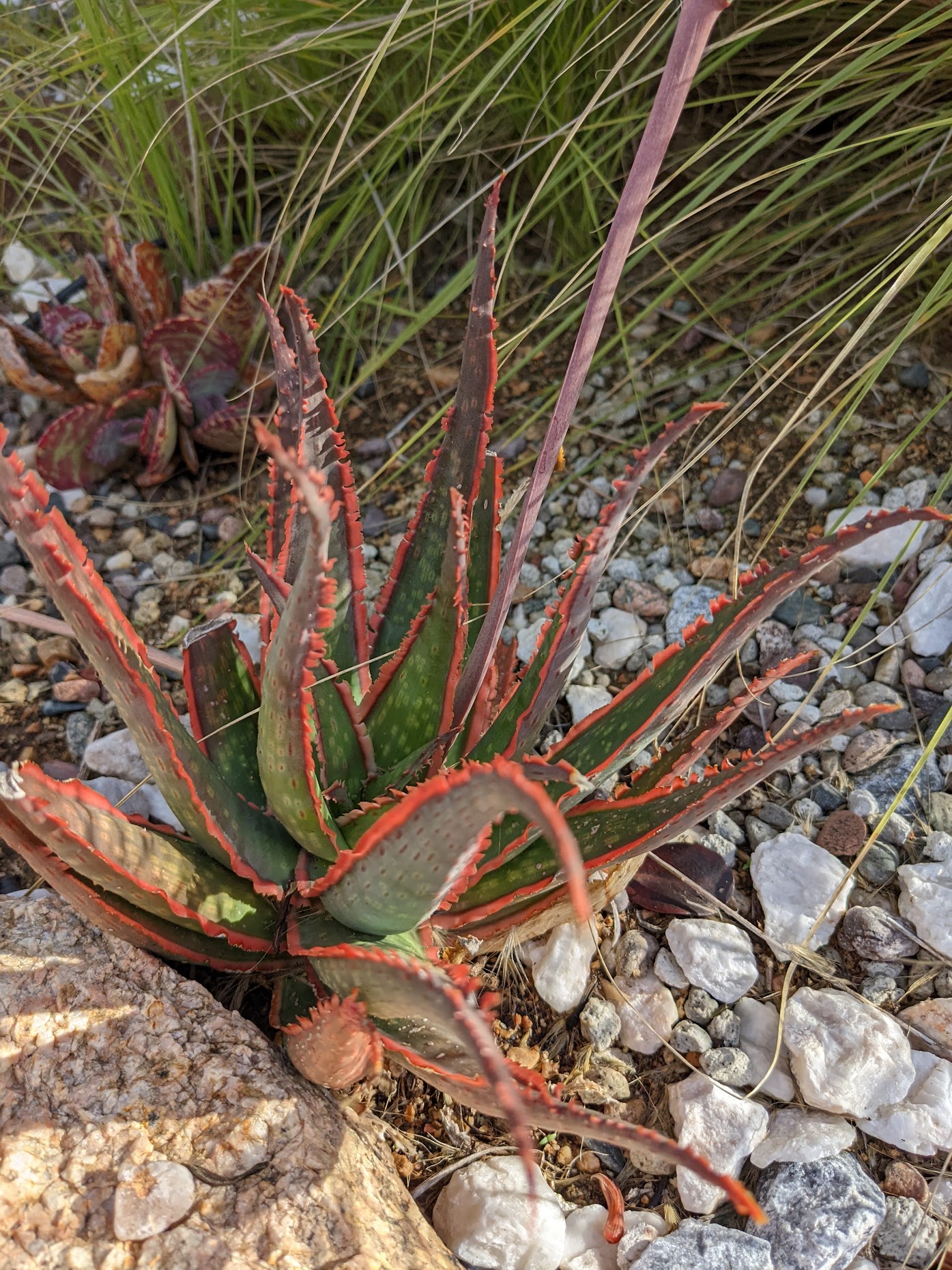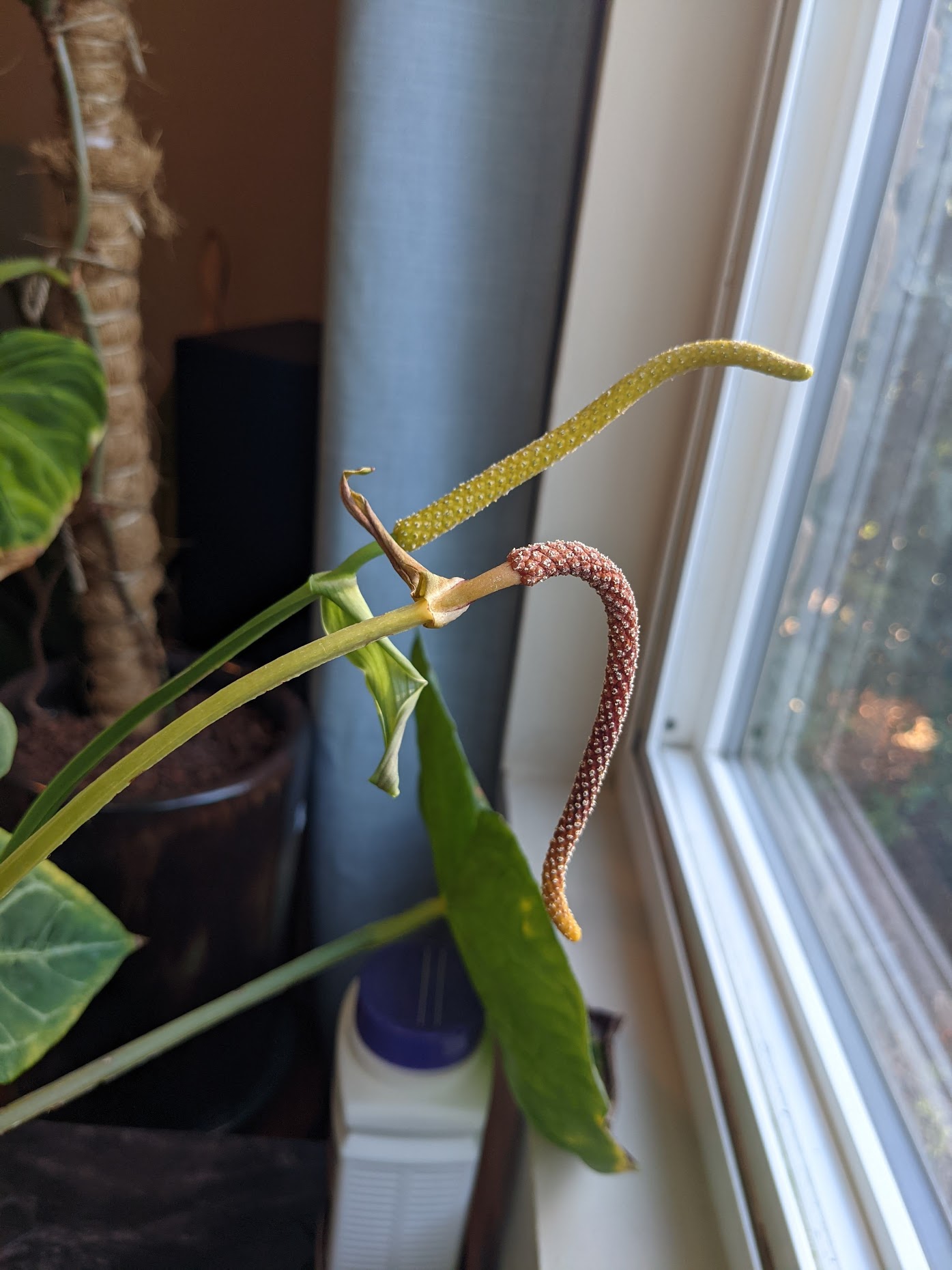New year, new projects! After a short hiatus for the holidays and unusual weather for San Diego, we’ve been busy over in our little garden corner!
The weather was the most draining part of the month. We had nearly 4″ of rain over the course of 8 days, which for us is highly unusual. Before this, we’d had barely 1/4 of an inch in our area for the 2021 – 2022 rainfall season. Getting 4″ in the space of two weeks was a lot! The weeks before that, we had the earliest winter frost I’ve ever experienced at this house, on December 14th. Normally we don’t get frost until mid to late January, with a handful of ultra-cold nights possible in February.
Naturally, the aloes are all thrilled with this, and are producing bloom stalks left and right. My aculeatas are both blooming, although I’m doubtful they’ll coincide well enough for some pure seeds to be produced. This first year with two my plan is to carry over some of the star aloe hybrids and place them nearby to encourage some hummingbird pollination. That tactic worked exceptionally well for my mature book aloe, and I was lucky enough that only one aloe hybrid was blooming at the time, so half of the stalk is a definite aloe suprafoliata x aloe “coral fire” cross. The upper half could be coral fire, sunrise, or krakatoa.

My smaller/younger Aloe aculeata producing its first bloom stalk. It’ll be another week or two before this is close to the same blooming stage as the one pictured right.

This book aloe produced one bloom stalk, and as my other book aloes aren’t mature enough to flower yet, I had to hunt for other aloes to pair it with. It was the first to go this year, and I ended up having to carry the pot down to my ledge of aloe hybrids to keep it close to other blooms! This is also a hugely popular spot for our hummingbirds, so pollination was highly likely.

My oldest Aloe aculeata – with age, they produce more bloom stalks at once, but they only bloom once a year. I’ve set seed successfully on these only once before, but never grown the outcome. Maybe this year!

This Aloe Coral Fire was one of the first hybrids I ever took home, and I’ve divided it quite a few times. This clump was blooming right as the book aloe was, so I left the book aloe right next to it so the hummingbirds would have an easy time feeding. Hummingbirds are about as perfect of pollinators for aloes as you can get, and this was very successful! I can’t wait for the seeds.
Indoors, I also had some successful flowering and pollination taking place. My Anthuriums are all fairly sad at the moment, with the dry air from the furnace making it a challenge to keep their leaves pretty – but my magnificum and clarinervium both bloomed at the same time!
Those blooms and attempted cross-pollination didn’t work, but I was lucky enough that my larger Anthurium magnificum had two blooms at the same time that also happened to be at ideal stages in their bloom cycle. I’ll post about the process and getting the seeds started once they’ve finished ripening.
I also have been dealing with the annual spider-mite issue that seems to pop up every winter. Some bonide houseplant systemic granules in the soil combined with multiple spray treatments seems to have knocked them out for this year, but I won’t be confident for a couple more weeks. This year, I used Ortho’s 3-in-1 food-safe spray, then 3 weeks later, followed it with the bioadvanced tree and shrub systemic spray. It’s been two weeks since that second treatment, and no sign yet, so cross your fingers!

Above are the two blooms at different stages. The bloom in the foreground is spent, and clearly didn’t get pollinated, while the one in back is the color that indicates it’s reaching the pollen-producing stage. It’s relatively plump and compared to the earlier bloom, it’s ever so slightly less “deflated” looking at this stage, which is a sign it’s been successfully pollinated.
I’ve seen plenty of videos online, read blogs, and numerous people on Instagram have assured me it is easy to get pollen off Anthurium blooms, and it’s easy to use a paintbrush to apply the pollen and fertilize your Anthuriums…but not for me.
Each morning from November 17 through the 19th, I rubbed the two blooms above all over each other exactly as the video above shows. To date, that’s the only way I’ve successfully pollinated my Anthuriums. Prior to this, I successfully created pure Anthurium forgetii seeds which are growing up to a sale-ready size now.
I’ve brought in a handful of my tropical plants to keep them warm for winter, although I didn’t do so early enough for my beloved Philodendron gigas.

The older the leaves, the quicker they succumbed to cold damage, which you can see left. It tolerated night time lows to 50F, but didn’t really produce much new growth, and when nights began reaching the low 40s I started seeing discoloration.
The cold swept in faster than I expected, and numerous leaves developed first a white discoloration, almost like frost. It was not frost, or pests – just the early signs of cold damage. After being brought inside, the leaves turned yellow and brown and have been falling off.
I’ll be propagating this as soon as space is available in my glass grow case. Nearly all the leaves below the top growth point were damaged and fell off, so the poor thing is quite sad looking.
Moving back outdoors to the greenhouse and the xeric plants, my autumn-started mesemb seeds are all thriving still. The argyrodermas are all splitting and producing their first true leaves, as are the lapidera. No side of initial division from the lithops or conophytums, but that may take months yet. I’m hopeful that when the weather starts warming more at night, I’ll see the lithops divide.
My greenhouse is not heated, so night time lows are only slightly above the outdoor temperatures. This means most nights in the past few weeks, the greenhouse has been in the low 30s. When it’s sunny, the daytime highs will reach 90F, but on cloudy days its rarely above 70F.
For most of December, I only watered my winter-growers: the aloes, euphorbias, stapeliads, lithops, and a handful of thirsty-looking succulents. The cacti have all gone nearly a month without any water, with their first tiny splash of a drink being on 01/04 with the prospect of several warm, sunny days ahead of us.

Argyroderma framesii v minus seedlings with their first true leaves. At right, a NOID Aloe hybrid I used for some hand pollination practice in the greenhouse. I am no where near as effective as the hummingbirds!

I’ve also started sowing seeds to grow up and be ready for the greenhouse by this spring. Since cacti and succulents take so long to reach a size suitable for sale, these are species I hope to have available by 2024 at the earliest – it’ll be quite the wait!
I started my first 400 Mesa Garden seeds last week, and several hundred of my own hand pollinated seeds two weeks before that. Neither set of seeds began sprouting until we had a few days of sunshine, so if we get more of that prolonged rain and clouds, I’ll have to set up a grow light to supplement them. Below are the species I’ve sown or will sow for the upcoming 2022 growing season:
Lithops rushishorum var rushishorum C242
Tanquana hilmarii
Lithops lesliei ssp lesliei var lesliei (warrenton) C036
Dinteranthus vanzylii
Lithops divergens v divergens C269
Lithops dorotheae C124
Lapideria margaretae
Aloinopsis luckhoffii CM38 / 17/
Lithops otzeniana (Towskoppie, Loriesfotein)
Lithops lesliei cv Albinica C36A
Lithops fulviceps v lactinea C222
Lithops hallii (Geluksvlei)
Gibbaeum cryptopodium
Lithops otzeniana
Astrophytum myriostigma (SB340)
Lobivia haagei
Sulcorebutia purpurea
Thelocactus bicolor
Pilosocereus pachycladus (CS154)
Conophytum pellucidum
Lithops bromfieldii C41
Argyroderma framesii v minus
Argyroderma delaetii Bitterfontein
Conophytum meyerae RR1213 (Doringrivier)
Lithops villetii ssp deboeri C230A
Lithops karasmontana ssp. Bella (s. Pockenbank)
Lithops julii ssp. Fulleri C323
Lithops karasmontana ssp bella SB2181 Aus
Lithops terricolor C134 (Prince Albert SA)
Lithops dorotheae C124 /D/
Cephalophyllum ceresianum (skitterykloof)
Coryphantha poselgeriana
Astrophytum myriostigma (SB264)
Gymnocalycium spegazzini (STO-924)
Astrophytum myriostigma #62.2
Echinopsis obrepanda
Gymnocalycium pflanzii var albipulpa
Gymnocalycium pflanzii var riograndense
Gymnocalycium rotundum
Noechilenia jussui
Notocactus buiningii
Notocactus turececkianus
Pilosocereus azureus
Leuchtenbergia princeps
Echinocactus horizonthalonius
Strombocactus disciformis
Coryphantha macromeris
Neoporteria napina
Thelocactus hexaedrophorus
Astrophytum capricorne #70.03
Astrophytum capricorne #55.5
Neoporteria curvispina
Matucana madisoniorum
Neoporteria paucicostata (KK67)
Glandulicactus uncinatus
Glandulicactus uncinatus
Ferocactus macrodiscus
Find out when my seeds, seedlings, or propagated plants are available by signing up for my mailing list!
Emails are few – I only send something when I have a new batch of plants ready to go.


